
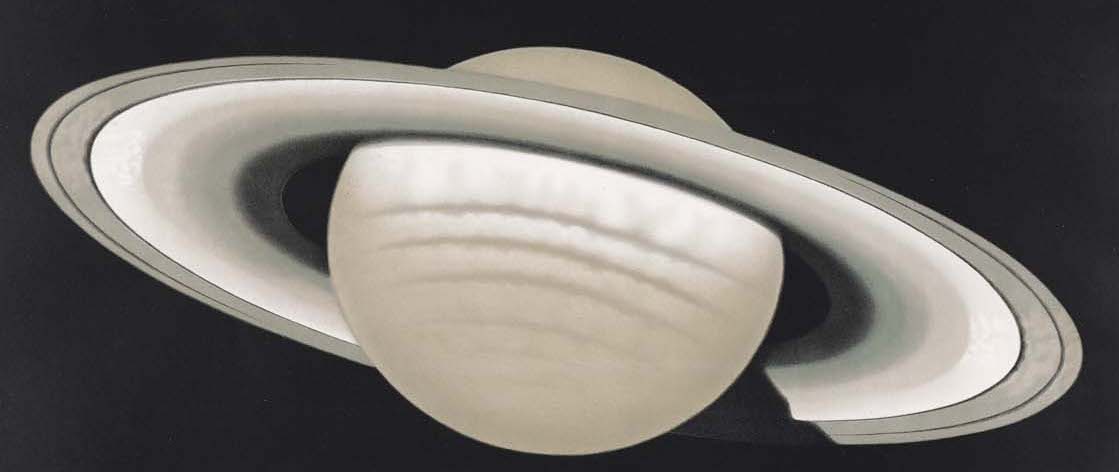
The French-born artist and lithographer Étienne Léopold Trouvelot (1827–1895) was also an amateur astronomer with the remarkable ability to synthesize his observations into sensitive and informative images. His drawings of a meteor shower in November 1868 [A4] and of auroras led him to the Harvard College Observatory, where he made some 1,000 sketches, from which he drew, and prepared the lithographic plates for, thirty-five “Astronomical Engravings” (1872–75) for the observatory’s director, Joseph Winlock. Trouvelot continued this work for the U.S. Naval Observatory [A8] and then, after 1882, for the Paris Observatory back in France. All told, he prepared some 7,000 sketches of astronomical phenomena.
By 1881, Trouvelot had prepared a new set of fifteen large pastel drawings that “illustrate the principal classes of celestial objects and phenomena.” From these he supervised the production of the chromolithographs on display here [A1–A15]. They are arranged here in five groups, working outwards from the earth; each plate is accompanied by his own description, from The Trouvelot Astronomical Drawings Manual (New York, 1882).
The titles of many of Trouvelot’s chromolithographs state that the image was taken at a precise moment, but none in fact were. At the stated moment, Trouvelot would have sketched the whole scene—using a fine grid of wires within the telescope eyepiece to ensure spatial accuracy—but he filled in the details from his more detailed sketches and precise studies. He could therefore give celestial features great subtlety and refinement:
“A well-trained eye alone is capable of seizing the delicate details of structure and of configuration of the heavenly bodies, which are liable to be affected, and even rendered invisible, by the slightest changes in our atmosphere.”
“The view presents the rare spectacle of an aurora spanning the sky from east to west in concentric arches. The Polar Star is nearly central in the back-ground, the constellation of the Great Bear on the right and Cassiopeia’s chair on the left. The large star at some distance above the horizon on the right is Arcturus. The almost black inner segment of the aurora resting upon the horizon, has its summit in the magnetic meridian, which was in this case a little west of north, its arc being indented by the bases of the ascending streamers. Both streamers and arches were, when observed, tremulous with upward pulsations and there was also a wave-like movement of the streamers from west to east. The prevailing color of this aurora is a pale whitish green and the complementary red appears especially at the west end of the auroral arch. The summits of the streamers are from four hundred to live hundred miles above the earth and the aurora is therefore a phenomenon of the terrestrial atmosphere rather than of astronomical observation proper.”
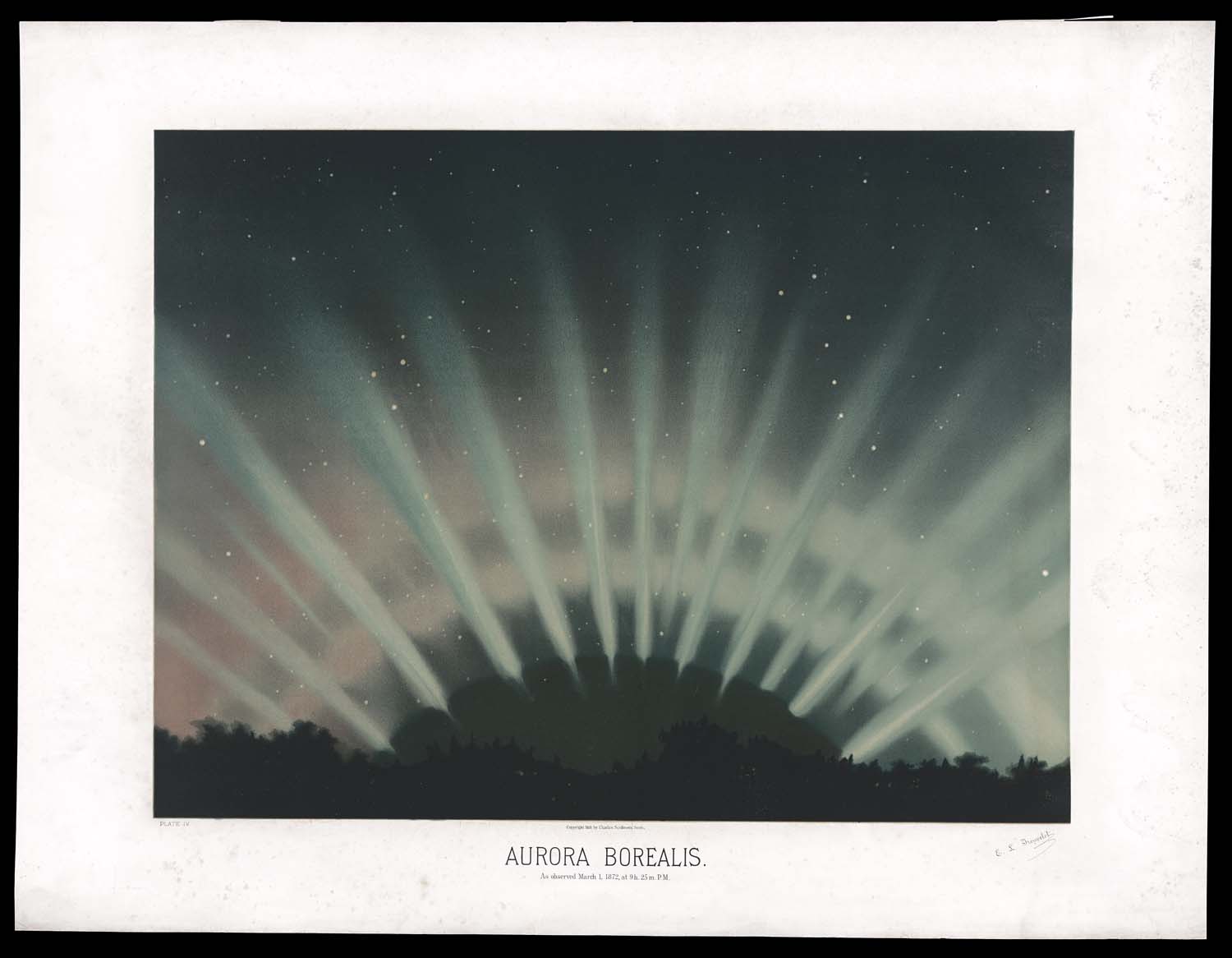
map/50073
Etienne Leopold Trouvelot, Aurora Borealis
From The Trouvelot Astronomical Drawings (New York: Charles Scribner's Sons, 1881), plate IV
Chromolithograph, 53 x 70.5 cm
OML Collection
URL: www.oshermaps.org/map/50073
“An observation of the cone of light whose axis lies along the Zodiac, whence it derives its name. It is drawn as seen in the west, with its base in the constellation Pisces, and its apex near the familiar group of the Pleiades in the constellation Taurus. The first bright star above the horizon in the base of the cone is the planet Venus and at some distance above is the reddish disk of Mars, the two being in rare companionship as evening stars. Above the constellation Pisces, two bright stars of Aries lie just outside the cone at the right. The nearest bright star above these at the right is Beta, the leading star of the constellation Triangula. Further at the right the three prominent stars nearly in a line are, in ascending order, Delta, Beta and Gamma of the constellation Andromeda. Above these at the left, the brightest star of a quadrangular group of four is the remarkable variable star Algol (Beta) of the constellation Perseus, which changes from the second to the fourth magnitude in a period of less than three days. At the left and a little above the Pleiades is the ruddy star Aldebaran, one of the Hyades and chief star in the constellation Taurus. These are the principal stars visible in this portion of the sky at the time of the observation. Their relative positions are represented as seen in the sky and not by the common method of star-atlases, which allows for the change from a spherical to a plane surface. Their magnitude in the order of brightness is indicated only approximately.”
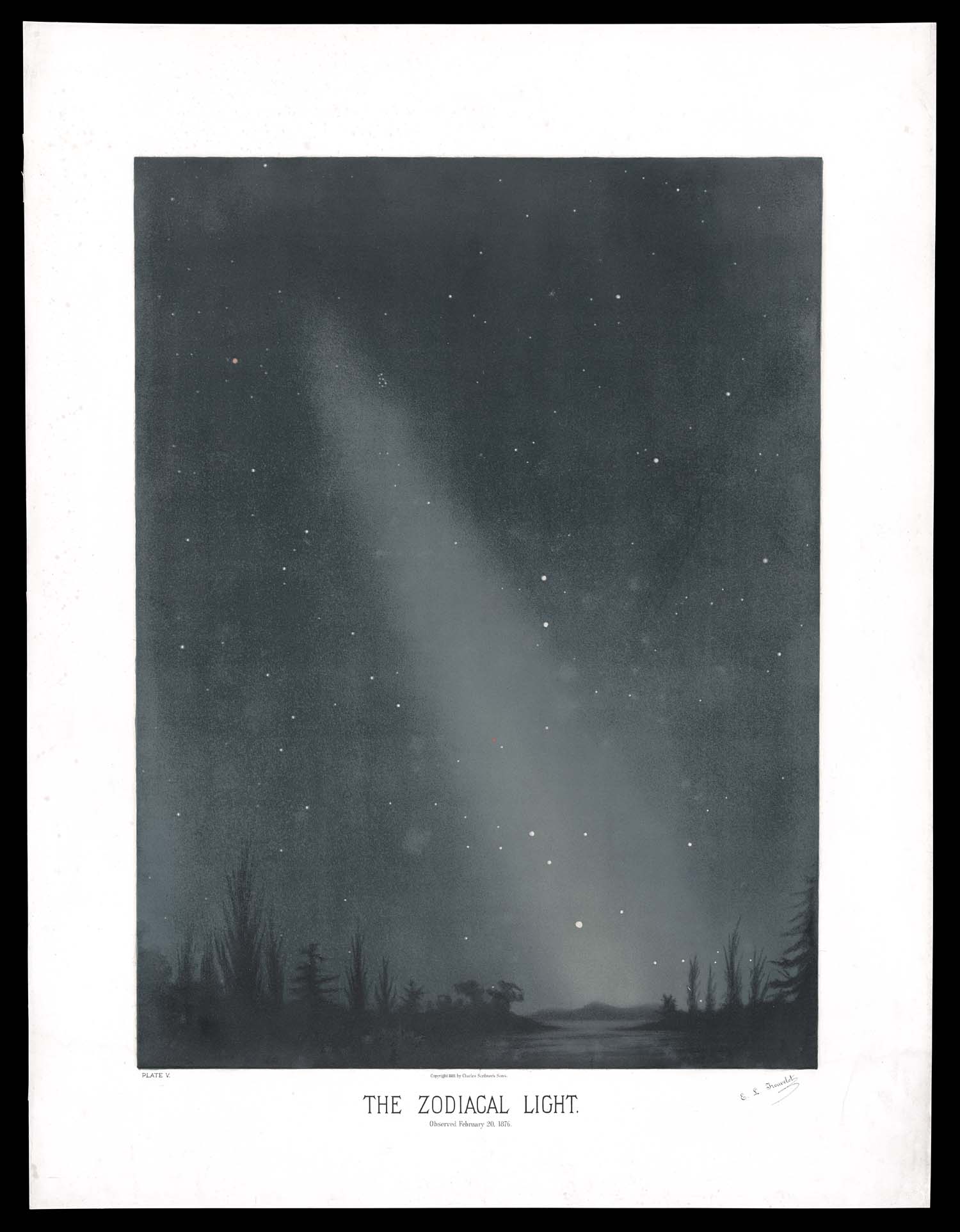
map/50074
Etienne Leopold Trouvelot, The Zodiacal Light
From The Trouvelot Astronomical Drawings (New York: Charles Scribner's Sons, 1881), plate V
Chromolithograph, 53 x 70.5 cm
OML Collection
URL: www.oshermaps.org/map/50074
“A view of the comet 1881, III., drawn as if seen with the naked eye, the minute details, however, being reproduced as seen with the telescope. The star-like nucleus is attended by four conical wings which cause it to appear diamond-shaped. The coma appears double, the brilliant inner coma, immediately enveloping the nucleus, being surrounded by a fainter exterior coma, which has a noticeable depression corresponding to that of the inner edge of the principal coma. The tail is divided lengthwise by a dark rift and is brightest on its convex or forward side. An inner portion of the tail, brighter than the rest, is more strongly curved, as if by solar repulsion. Stars are seen through the brighter parts of the tail, as they may be seen even through the coma and nucleus, with little diminution of their light.”
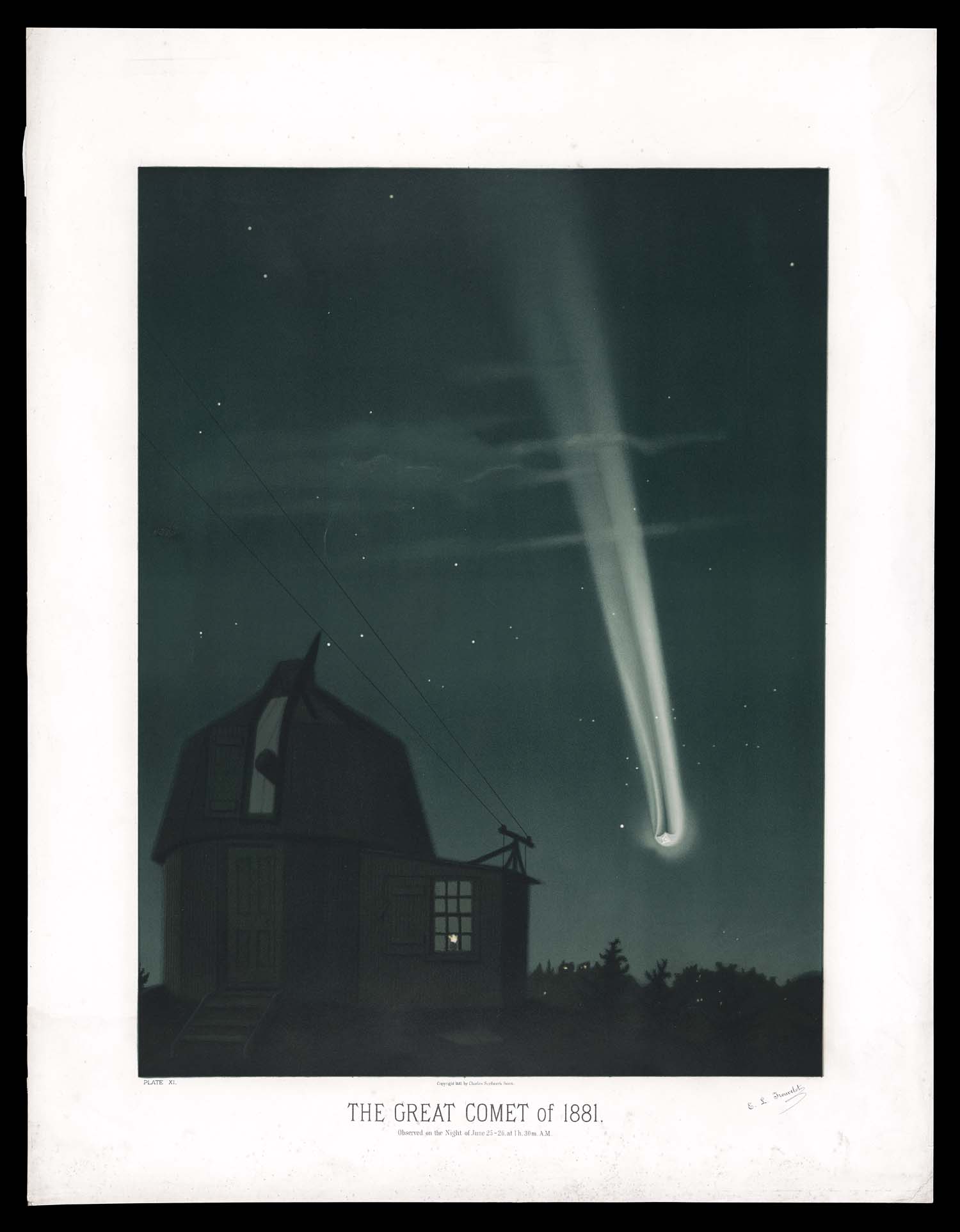
map/50080
Etienne Leopold Trouvelot, The Great Comet of 1881
From The Trouvelot Astronomical Drawings (New York: Charles Scribner's Sons, 1881), plate XI
Chromolithograph, 53 x 70.5 cm
OML Collection
URL: www.oshermaps.org/map/50080
“A partially ideal view of the November Meteors, combining forms observed at different times during the night of Nov.18th,1868. It is not, however, a fanciful view, since a much larger number of meteors were observed falling at once during the shower of November, 1833, and at other times. The locality of the observation is shown by the Polar Star seen near the centre of the Plate, and Cassiopeia’s Chair at the left. The general direction of the paths of the meteors is from the north-east, the radiant point of the shower having been in the constellation Leo, beyond and above Ursa Major. While the orbits of the meteors are, in general, curved regularly and slightly, several are shown with very eccentric paths, among them one which changed its course at a sharp angle. In the upper left-hand corner appear two vanishing trails of the “ring-form,” and several others still further transformed into faint luminous patches of cloud. Red, yellow, green, blue and purple tints were observed in the meteors and their trails, as represented in the Plate.”
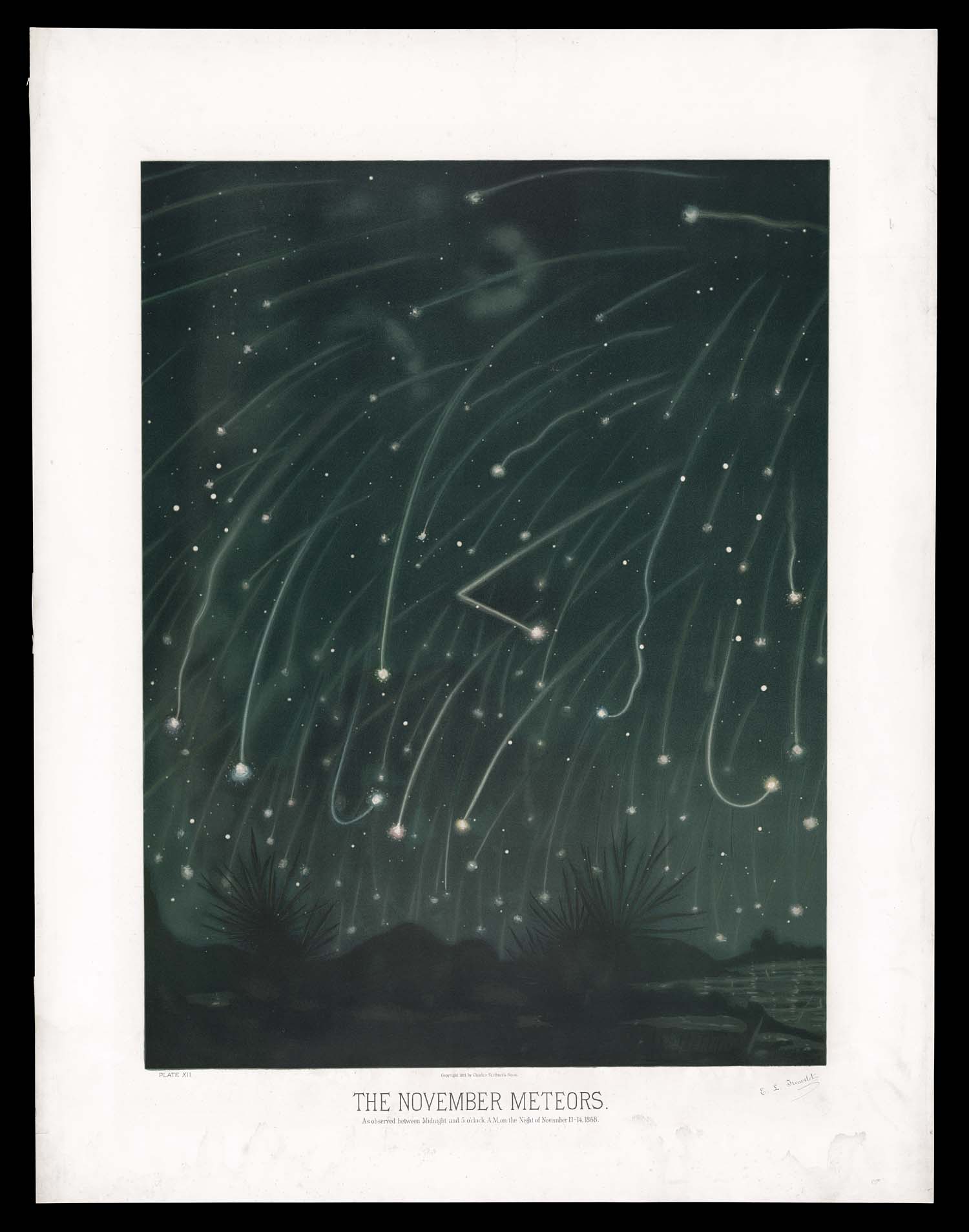
map/50081
Etienne Leopold Trouvelot, The November Meteors
From The Trouvelot Astronomical Drawings (New York: Charles Scribner's Sons, 1881), plate XII
Chromolithograph, 53 x 70.5 cm
OML Collection
URL: www.oshermaps.org/map/50081
“The course of the portion of the Galaxy represented in Plate XIII. is as follows: From Cassiopeia’s chair, three bright stars of which appear at the upper edge of the Plate, the Galaxy, forming two streams, descends south, passing partly through Lacerta on the left, and Cepheus on the right; at this last point it approaches nearest to the Polar Star, which is itself outside of the field of view. Then it enters Cygnus, where it becomes very complicated and bright, and where several large cloudy masses are seen terminating its left branch, which passes to the right, near the bright star Deneb, the leader of this constellation. Below Deneb, the Galaxy is apparently disconnected and separated from the northern part by a narrow, irregular dark gap. From this rupture, the Milky-way divides into two great streams, separated by an irregular dark rift. An immense branch extends to the right, which, after having formed an important luminous mass between the stars Gamma and Beta, continues its southward progress through parts of Lyra, Vulpecula, Hercules, Aquila and Ophiuchus, where it gradually terminates a few degrees south of the equator. The main stream on the left, after having formed a bright mass around Epsilon Cygni, passes through Vulpecula and then Aquila, where it crosses the equinoctial just below the star Eta, after having involved in its nebulosity the bright star Altair, the leader of Aquila. In the southern hemisphere the Galaxy becomes very complicated and forms a succession of very bright, irregular masses, the upper one being in Scutum Sobieskii, while the others are respectively situated in Sagittarius and in Scorpio; the last, just a little above our horizon, being always considerably dimmed by vapors. From Scutum Sobieskii, the Galaxy expands considerably on the right, and sends a branch into Scorpio, in which the fiery red star Antares is somewhat involved. In the upper left-hand corner of the Plate, at some distance from the Milky-way, is seen dimly the Nebula in Andromeda, which becomes so magnificent an object to telescopic view.”
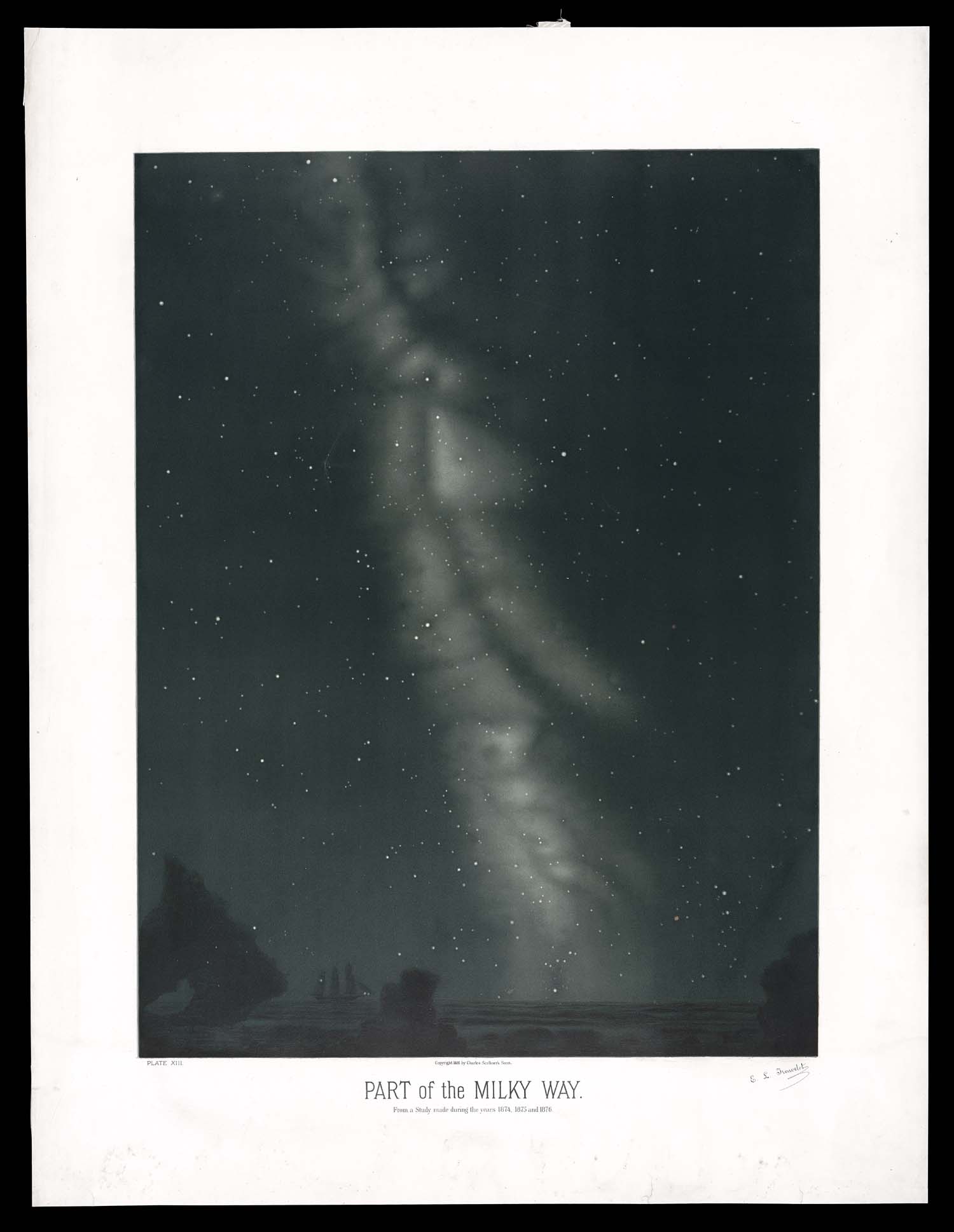
map/50082
Etienne Leopold Trouvelot, Part of the Milky Way
From The Trouvelot Astronomical Drawings (New York: Charles Scribner's Sons, 1881), plate XIII
Chromolithograph, 53 x 70.5 cm
OML Collection
URL: www.oshermaps.org/map/50082
“The background shows the sun’s visible surface, or photosphere, as seen with a telescope of high power at the most favorable moments, composed of innumerable light markings, or granules, separated by a network of darker gray. The granules, each some hundreds of miles in width, are thought to be the flame-like summits of the radial filaments or columns of gas and vapor which compose the photospheric shell. The two principal sun-spots of the group here represented show the characteristic dark umbra in the centre, overhung by the thatch-like penumbra, composed of whitish gray filaments. The penumbral filaments are not supposed to differ in their nature from those constituting the ordinary photosphere, save that they are seen here elongated and violently disturbed by the force of gaseous currents. Both spots are traversed partly or wholly by bright overlying faculæ, or so-called luminous bridges, depressed portions of which, in the left-hand spot, form the gray and rosy veils commonly attendant upon this class of spots. In each of these spots, also, the inner ends of projecting penumbral filaments have fallen so far within the umbra as to appear much darker than the rest. At the right of the upper portion of the left-hand spot, is a mass of white facular clouds, honey-combed by dark spaces, through which are seen traces of the undeveloped third spot of the triple group first observed. If seen upon the sun’s limb, this would have presented the appearance of a lateral spot. Above the right-hand spot is a small black “dot,” or incipient spot, without distinct penumbra. Their regular dark rift below the two large spots and connecting them is a spot of the crevasse type, with very slight umbra, a still better example of which is seen in a westward prolongation of the penumbra of the left-hand spot. In the upper left-hand corner of the Plate are seen several small faculæ, appearing as irregular whitish streaks amongst the granules. In the pear-shaped darkening of the solar surface below and at their left, is seen a veiled spot, two of which attended this group.
Approximate scale, 2500 miles — 1 inch.”
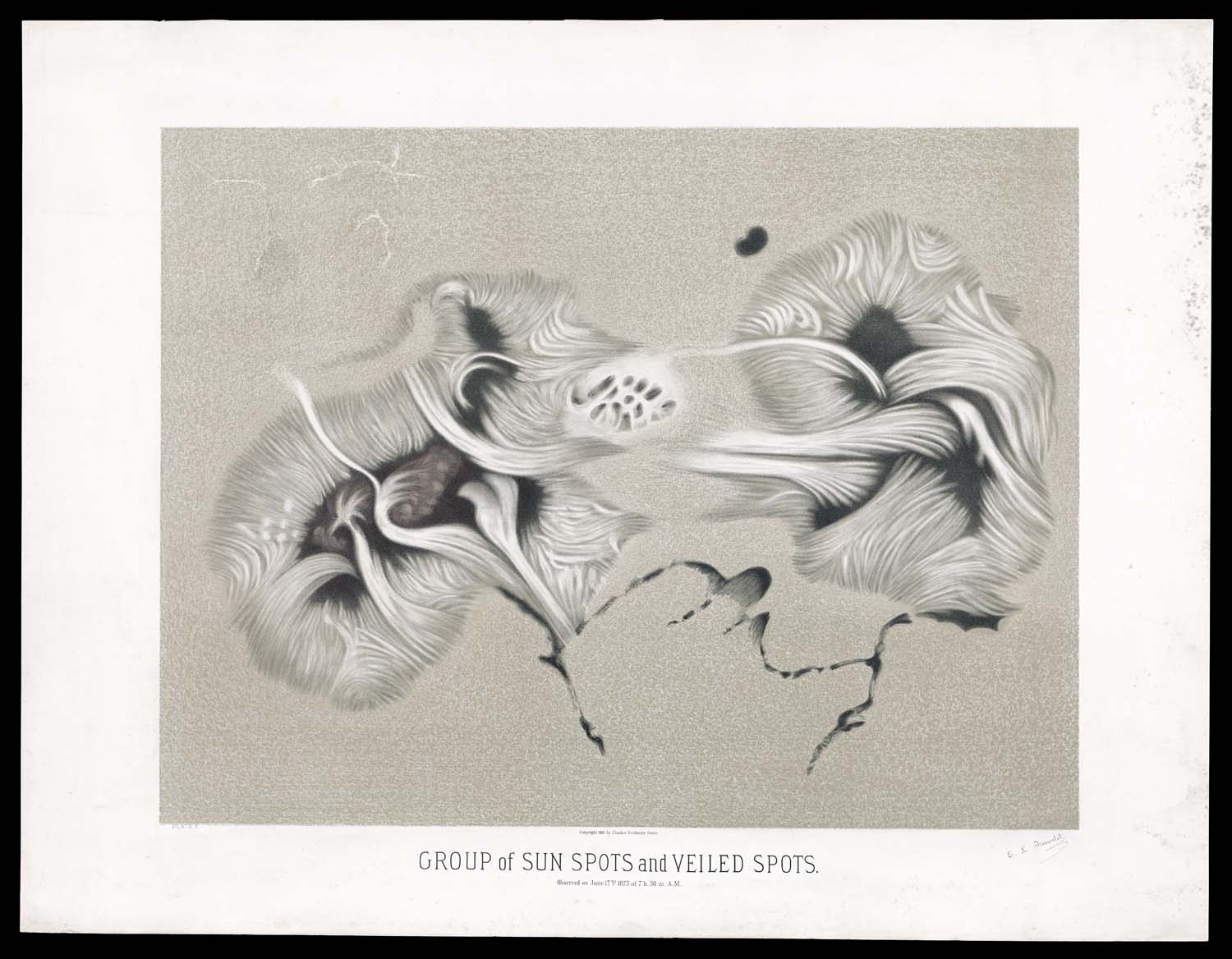
map/50070
Etienne Leopold Trouvelot, Group of Sun Spots and Veiled Spots
From The Trouvelot Astronomical Drawings (New York: Charles Scribner's Sons, 1881), plate I
Chromolithograph, 53 x 70.5 cm
OML Collection
URL: www.oshermaps.org/map/50070
“A view of an upheaval of the chromosphere, or third outlying envelope of the sun, as observed with the…telescope with spectroscope attached.
The black background represents the general darkness of the eye-piece to the spectroscope. The broad red stripe stretching from top to bottom of the Plate is a portion of the red band of the spectrum, magnified about 100 times as compared with the actual spectroscopic view. The upper and lower edges of the cross-section of dusky red correspond with the edges of the slit, opened widely enough to admit a view of the chromospheric crest and of the whole height of the protuberance at once. With a narrower opening of the slit this background would have been nearly black, its reddish cast increasing with the amount of opening and consequent admission of diffused sun-light. Rising above the lower edge of the opening is seen a small outer segment of the chromosphere, which, as a portion of the sun’s eastern limb, should be imagined as moving directly towards the beholder. The seams and rifts by which its surface is broken, as well as the distorted forms of the huge protuberances show the chromosphere to be in violent agitation. Some of the most characteristic shapes of the eruptive protuberances are presented, as also cloud-like forms overtopping the rest. In the immediate foreground the bases of two towering columns appear deeply depressed below the general horizon of the segment observed, showing an extraordinary velocity of motion of the whole uplifted mass toward the observer. The highest of these protuberances was 126,000 miles in height at the moment of observation. The triple protuberance at the left with two drooping wings and a tall swaying spire tipped with a very bright flame, shows by its more brilliant color the higher temperature (and possibly compression) to which its gases have been subjected. The irregular black bands behind this protuberance indicate the presence there of less condensed and cooler clouds of the same gases. The dimmer jets of flame rising from the chromosphere are either vanishing protuberances, or, as in the case of the smallest jet shown at the extreme right of the horizon, are the tops of protuberances just coming into view.
Approximate scale, 6000 miles — l inch.”
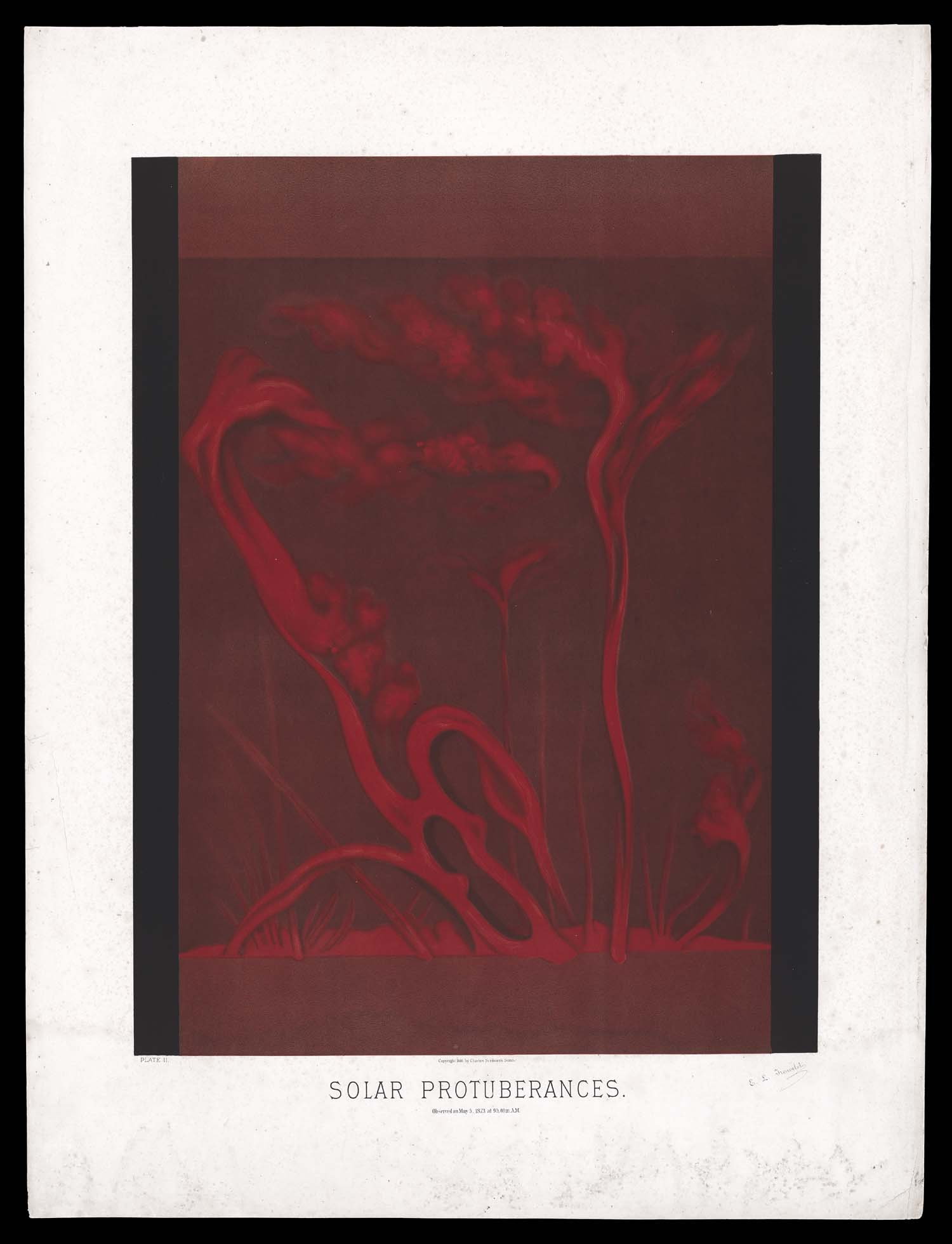
map/50071
Etienne Leopold Trouvelot, Solar Protuberances
From The Trouvelot Astronomical Drawings (New York: Charles Scribner's Sons, 1881), plate II
Chromolithograph, 53 x 70.5 cm
OML Collection
URL: www.oshermaps.org/map/50071
“A telescopic view of the sun’s corona or extreme outer atmosphere and of the solar flames or prominences during a total eclipse. At the moment of observation the dark disk of the moon, while still hiding the sun’s main body, had passed far enough eastward to allow the rosy pink chromospheric prominences to be seen on its western border. On all sides of the sun’s hidden disk, the corona shows its pale greenish light extending in halo-like rays and streamers, and two very remarkable wings stretch eastward and westward very nearly in the plane of the ecliptic and in the direction of the positions of Mercury and Venus respectively at the time of observation. The full extent of these wings could not be shown in the Plate without reducing its scale materially, since the westerly wing extended no less than twelve times the sun’s diameter, and the easterly wing nearly as far, or over ten million miles. A circlet of bright light immediately bordering the moon’s disk is the so-called inner corona, next to which the wings and streamers are brightest, thence shading off imperceptibly into the twilight sky of the eclipse. Other noteworthy peculiarities of the corona, as observed during this ellipse, are the varying angles at which the radiating streamers are seen to project, the comparatively dark intervals between them, and the curved, wisp-like projections seen upon the wings. An especially noticeable gap appears where the most westerly of the upward streamers abruptly cuts off the view of the long wing. The largest and brightest of the curving streamers on the westerly wing coincides with the highest flame-like protuberance. To some observers of this eclipse the upward and downward streamers seemed pointed at their outer extremities and less regular in form.
Approximate scale, 135,000 miles — 1 inch.”
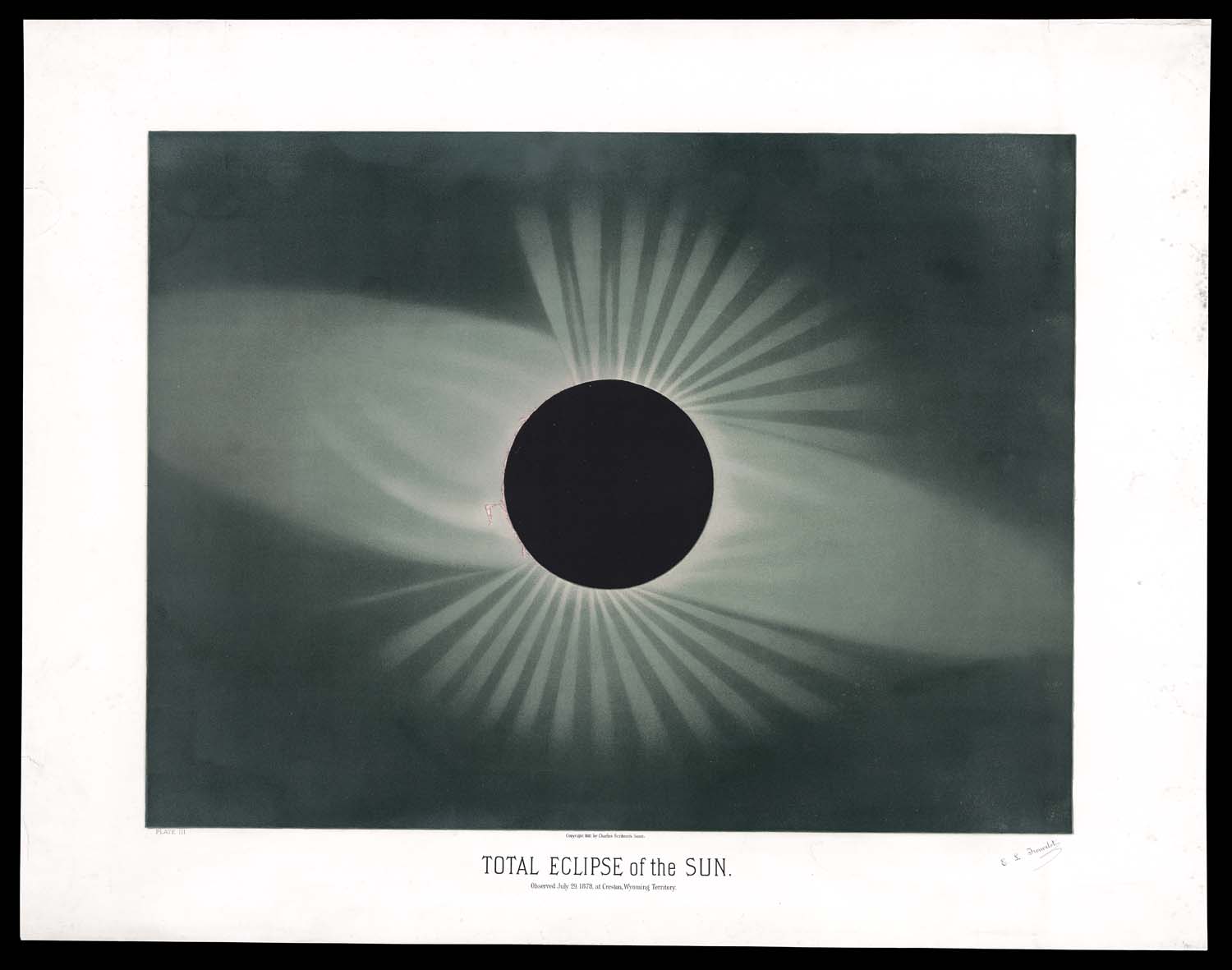
map/50072
Etienne Leopold Trouvelot, Total Eclipse of the Sun
From The Trouvelot Astronomical Drawings (New York: Charles Scribner's Sons, 1881), plate III
Chromolithograph, 53 x 70.5 cm
OML Collection
URL: www.oshermaps.org/map/50072
“A view of one of the lunar plains, or so-called seas (Maria), with an encircling mountainous wall consisting of volcano-like craters in various stages of subsidence and dislocation. The sun-light coming from the west casts strong shadows from all the elevations eastward, and is just rising on the terminator, where the rugged structure of the Moon’s surface is best seen. The lighter portions are the more elevated mountainous tracts and crater summits. …
The Mare Humorum, or sea of moisture, as it is called, is one of the smaller gray lunar plains. Its diameter, which is very nearly the same in all directions, is about 270 miles, the total area of this plain being about 50,000 square miles. It is one of the most distinct plains of the Moon, and is easily seen with the naked eye on the left-hand side of the disk. The floor of the plain is, like that of the other gray plains, traversed by several systems of very extended but low hills and ridges, while small craters are disseminated upon its surface. The color of this formation is of a dusky greenish gray along the border, while in the interior it is of a lighter shade, and is of brownish olivaceous tint. This plain, which is surrounded by high clefts and rifts, well illustrates the phenomena of dislocation and subsidence. The double-ringed crater Vitello, whose walls rise from 4,000 to 5,000 feet in height, is seen in the upper left-hand corner of the gray plain. Close to Vitello at the east is the large broken ring-plain Lee, and farther east, and a little below, is a similarly broken crater called Doppelmayer. [see item 27] Both of these open craters have mountainous masses and peaks on their floor, which is on a level with that of the Mare Humorum. A little below, and to the left of these objects, is dimly seen a deeply imbedded oval crater, whose walls barely rise above the level of the plain. …
In the lower part of the sea, and a little to the west of the middle line, is found the crater Agatharchides, which shows below its north wall the marks of rills impressed by a flood of lava, which once issued from the side of the crater. On the left-hand side of the plain is seen the half-demolished crater Hippalus resembling a large bay, which has its interior strewn with peaks and mountains. …
Approximate scale, 15 miles — 1 inch.”
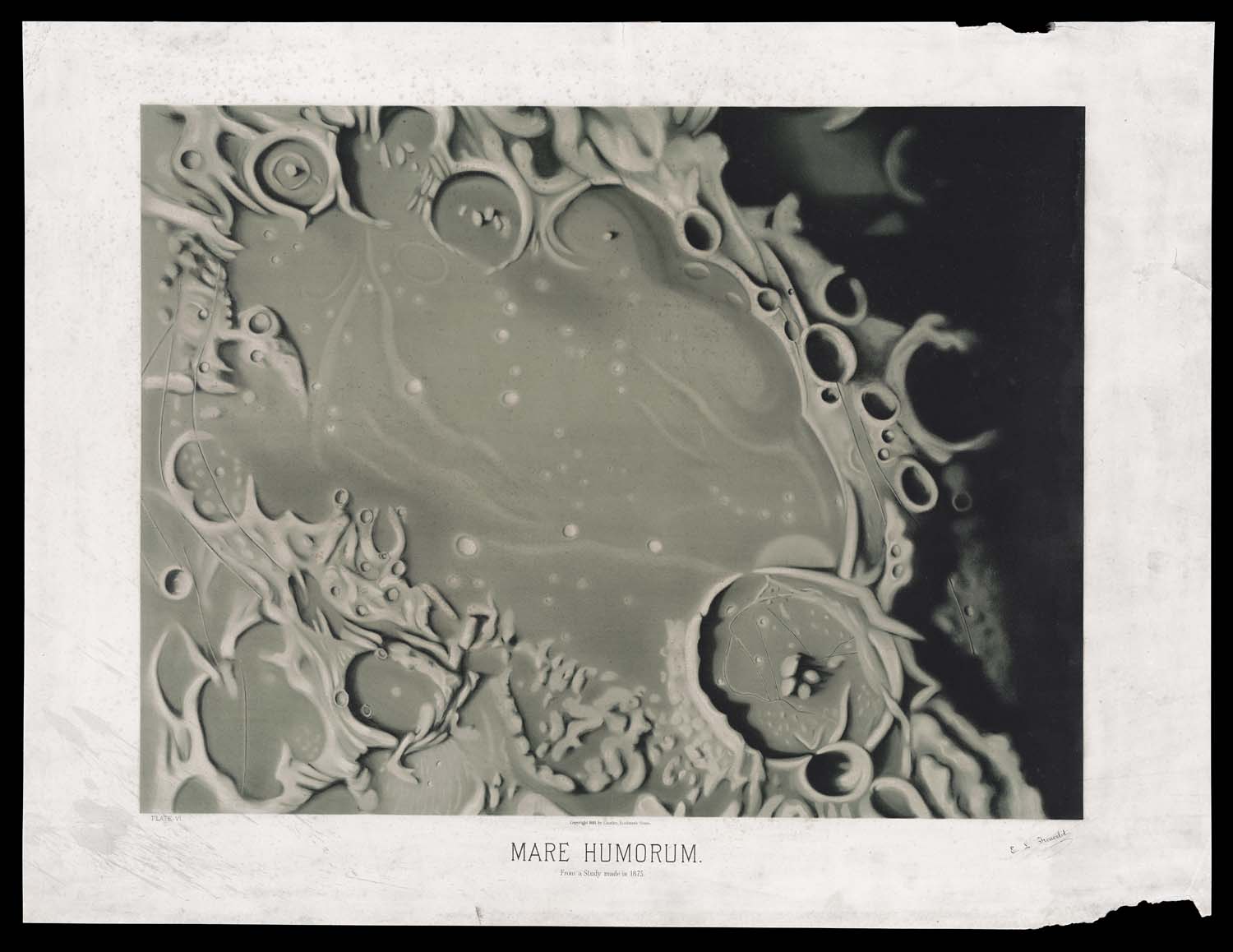
map/50075
Etienne Leopold Trouvelot, Mare Humorum
From The Trouvelot Astronomical Drawings (New York: Charles Scribner's Sons, 1881), plate VI
Chromolithograph, 53 x 70.5 cm
OML Collection
URL: www.oshermaps.org/map/50075
“A view of the Moon partially obscured by the Earth’s shadow, whose outline gives ocular proof of the earth’s rotundity of form. The shadowed part of the Moon’s surface is rendered visible by the diffused sun-light refracted upon it from the earth’s atmosphere. Its reddish brown color is due to the absorption, by vapors present near the earth’s surface, of a considerable part of this dim light. On both the obscured and illuminated tracts the configurations of the Moon’s surface are seen as with the naked eye. The craters appear as distinct patches of lighter color, and the noticeably darker areas are the depressed plains or Maria. The large crater Tycho, at the lower part of the disk, is the most prominent of these objects, with its extensive system of radiating streaks. The largest crater above is Copernicus, at the left of which is Kepler and still above are Aristarchus and Herodotus appearing as if blended in one. Above and at the left of the great crater Tycho, the first dark tract is the Mare Humorum of Plate VI. [item 9], seen in its natural position, with the crater Gassendi at its northern (upper) extremity and Vitello on its southern (lower) border. The advancing border of the shadow appears, as always, noticeably darker than the remainder, an effect probably of contrast. The illuminated segment of the Moon’s disk has its usual appearance, the lighter portions being the more elevated mountainous surfaces, and the dark spaces the floors of extensive plains.
Approximate scale, 140 miles — 1 inch.”
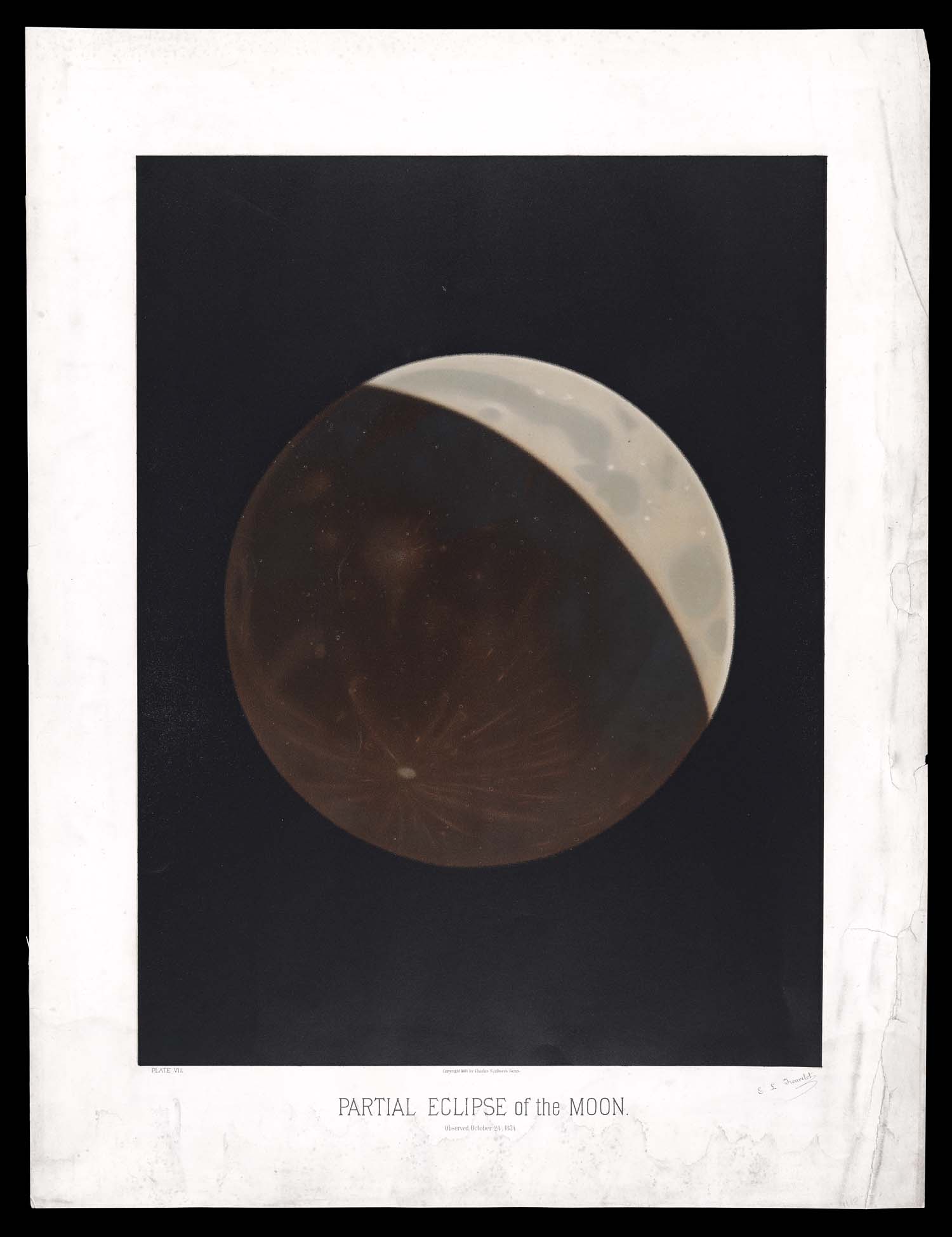
map/50076
Etienne Leopold Trouvelot, Partial Eclipse of the Moon
From The Trouvelot Astronomical Drawings (New York: Charles Scribner's Sons, 1881), plate VII
Chromolithograph, 53 x 70.5 cm
OML Collection
URL: www.oshermaps.org/map/50076
“A view of the southern hemisphere of Mars, when in the most favorable position for observation, and when exceptionally free from the clouds, which very frequently hide its surface configurations. Since, of all the planets, Mars is most like the earth, Plate VIII. may give a fair idea of the appearance of our globe to a supposed observer on Mars. The dark gray and black markings, are regarded as tracts of water, or of some liquid with similar powers of absorbing light; and, for the same reason, the lighter portions, of a prevailing reddish tint, are supposed to be bodies of land, while the bright white portions are variously due to clouds, to polar snow or ice, and the bright rim of white along the limb, to the depth of the atmosphere through which the limb is seen. The chief permanent features of the planet’s surface have been named in honor of various astronomers.
The large dark tract on the left is De La Rue Ocean, the isolated oval spot near the centre is Terby Sea, and on the right is the western end of Maraldi Sea, with strongly indented border. Directly north of (below) De La Rue Ocean, is Maedler Continent; above it stretches Jacob Land; and surrounding Terby Sea is Secchi Continent. Extending into the centre of De La Rue Ocean is a curious double peninsula, called, in consequence of the dimness of former observations, Hall Island. The sharply defined, white-crested northern borders of De La Rue Ocean and Maraldi Sea may indicate the existence there of lofty coast ranges, more or less constantly covered with opaque clouds strongly reflecting light. The white spot in the centre of Maedler Continent, of a temporary nature, has a similar explanation. The intervals of olivaceous gray on Secchi Continent and elsewhere may perhaps be ascribed to the flooding and drying up of marshes and lowlands, as these markings have been observed to vary somewhat in connection with the change of seasons on Mars. The greenish tints observed along the planet’s limb, alike on the darker and lighter surfaces, are probably due to an optical effect, the green being complementary to the prevailing red of the disk. The brilliant oval white spot near the southern (upper) pole of the planet is a so-called polar spot, in all probability consisting of a material similar to snow or ice and here observed in the midst of a dark open sea.
Approximate scale, 300 miles — 1 inch.”
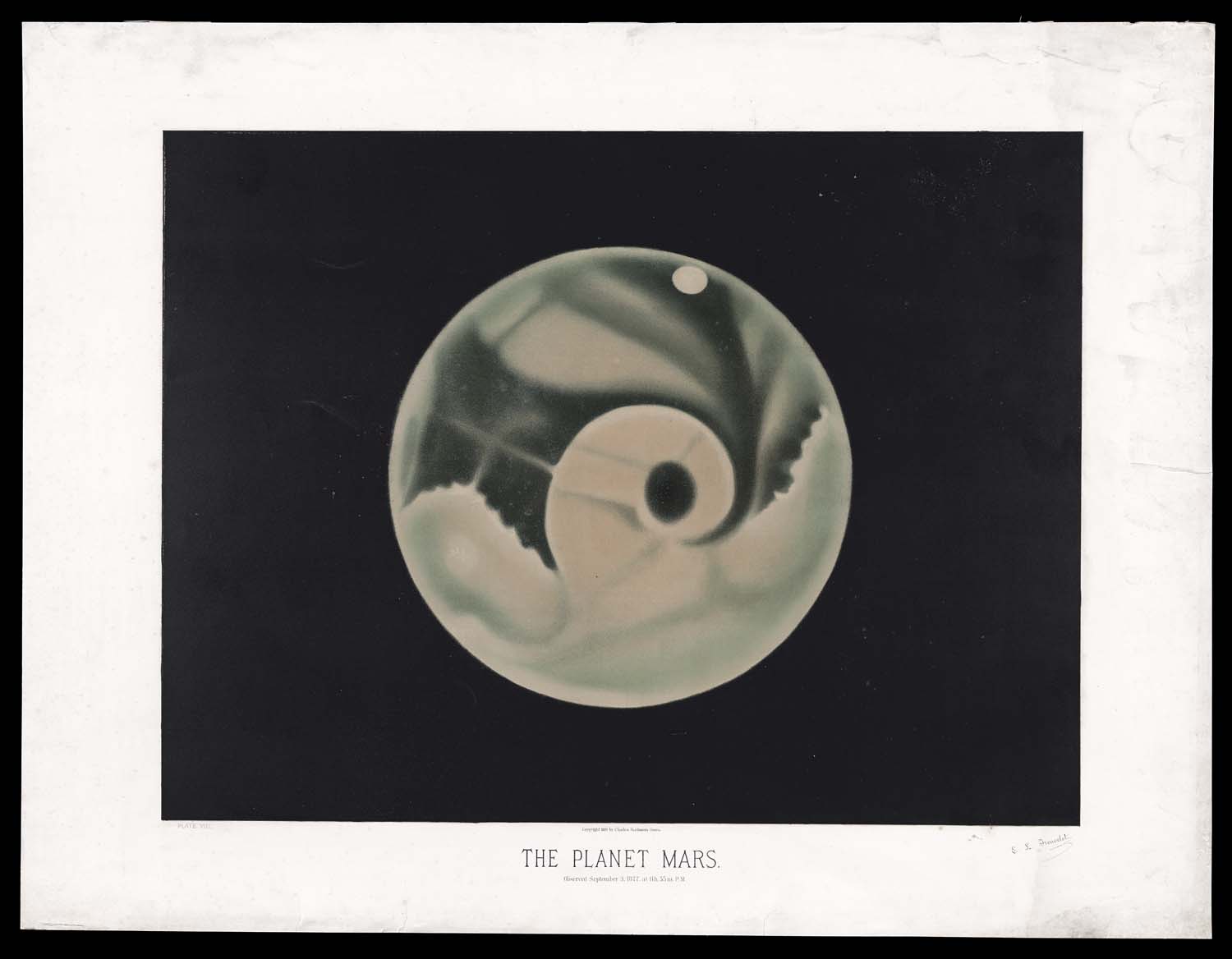
map/50077
Etienne Leopold Trouvelot, The Planet Mars
From The Trouvelot Astronomical Drawings (New York: Charles Scribner's Sons, 1881), plate VIII
Chromolithograph, 53 x 70.5 cm
OML Collection
URL: www.oshermaps.org/map/50077
“This planet is perpetually wrapped in dense clouds which hide its inner globe from view. The drawing shows Jupiter’s outer clouded surface with its usual series of alternate light and dark belts, the disk as a whole appearing brighter in the centre than near the limb. The darker gray and black markings indicate in general the lower cloud-levels; that is, partial breaks or rifts in the cloudy envelope, whose prevailing depth apparently exceeds four thousand miles. While the deepest depression in the cloudy envelope is within the limits of the Great Red Spot, the vision may not even here penetrate very deeply. Two of Jupiter’s four moons present bright disks near the planet’s western limb, and cast their shadows far eastward on the disk, that of the “second satellite” falling upon the Red Spot. On the Red Spot are seen in addition two small black spots, no explanation of which can yet be offered. The broad white ring of clouds bordering the Red Spot appeared in constant motion. The central, or equatorial belt, shows brilliant cloudy masses of both the cumulus and stratus types, and the underlying gray and black cloudy surfaces are pervaded with the pinkish color characteristic of this belt. The dark circular spots on the wide white belt next north showed in their mode of formation striking resemblances to sun-spots. They afterward coalesced into a continuous pink belt. The diffusion of pinkish color over the three northern most dark bands, as here observed, is unusual. About either pole is seen the uniform gray segment or polar cap. The equatorial diameter is noticeably longer than the polar diameter, a consequence of the planet’s extraordinary swiftness of rotation. To the same cause may also be due chiefly the distribution of the cloudy belts parallel to the planet’s equator, though the analogy of the terrestrial trade-winds fails to explain all the observed phenomena.
Approximate scale, 5,500 miles — 1 inch.”

map/50078
Etienne Leopold Trouvelot, The Planet Jupiter
From The Trouvelot Astronomical Drawings (New York: Charles Scribner's Sons, 1881), plate IX
Chromolithograph, 53 x 70.5 cm
OML Collection
URL: www.oshermaps.org/map/50078
“Saturn is unique amongst the planets in that its globe is encircled by a series of concentric rings,which lie in the plane of its equator, and consist, according to present theories, of vast throngs of minute bodies revolving about the planet, like so many satellites, in closely parallel orbits. The globe of Saturn, like that of Jupiter, is surrounded by cloudy belts parallel to its equator. The broad equatorial belt, of a delicate pinkish tint, is both brighter and more mottled than the narrower yellowish white belts, which alternate with darker belts of ashy gray on both the north and south sides, but are seen here only on the northern side. The disk has an oval shape, owing to the extreme polar compression of the globe.
The outer, middle and inner rings, with their various subdivisions, are clearly shown in Plate X., and are best seen on the so-called ansæ, or handles, projecting on either side. The gray outer ring is separated by the dusky pencil line into two divisions, both of which appear slightly mottled on the ansæ, as if with clouds. The middle ring has three subdivisions which are clearly distinguishable, although separated by no dark interval, viz., a brilliant white outer zone, distinctly mottled, as seen on the extremities of the ansæ and two interior zones of gradually diminishing brightness. The gauze or dusky ring is seen at its full width on the ansæ, but on the background of the strongly illuminated globe only its outer and presumably denser border is visible. The shadow of the globe on the rings is seen on the lower portion of the eastern ansa. The shadow on the dusky ring is with difficulty perceptible; the shadow on the middle ring is slightly concave toward the planet, which concavity is abruptly increased on the outer zone of this ring; while the shadow on the outer ring slants away from the globe. These appearances are fully accounted for by supposing a general increase of level from the inner edge of the dusky ring to the outer margin of the middle ring, and a uniform lower level on the outer ring. Other observers have regarded the deflection of the shadow as an effect of irradiation. The inner margin of the double outer ring presents on both ansæ; a number of slight indentations, which,if not actual irregularities in the contour of this ring, may be explained as shadows caused by elevations on the outer border of the middle ring, or possibly by overhanging clouds.
Approximate scale, 6,500 miles — 1 inch.”

map/50079
Etienne Leopold Trouvelot, The Planet Saturn
From The Trouvelot Astronomical Drawings (New York: Charles Scribner's Sons, 1881), plate X
Chromolithograph, 53 x 70.5 cm
OML Collection
URL: www.oshermaps.org/map/50079
“In the constellation Hercules, a small nebulous mass is faintly visible to the eye, a telescopic view of which is presented in Plate XIV. It is one of the most beautiful of the easily resolvable globular clusters. The brilliancy of the centre gives the cluster a distinctly globular appearance, while the several wings curving in various directions, have suggested to some observers an irregularly spiral structure. The large stars of the cluster are arranged in several groups which correspond, in a general way, with the faintly luminous wings.”
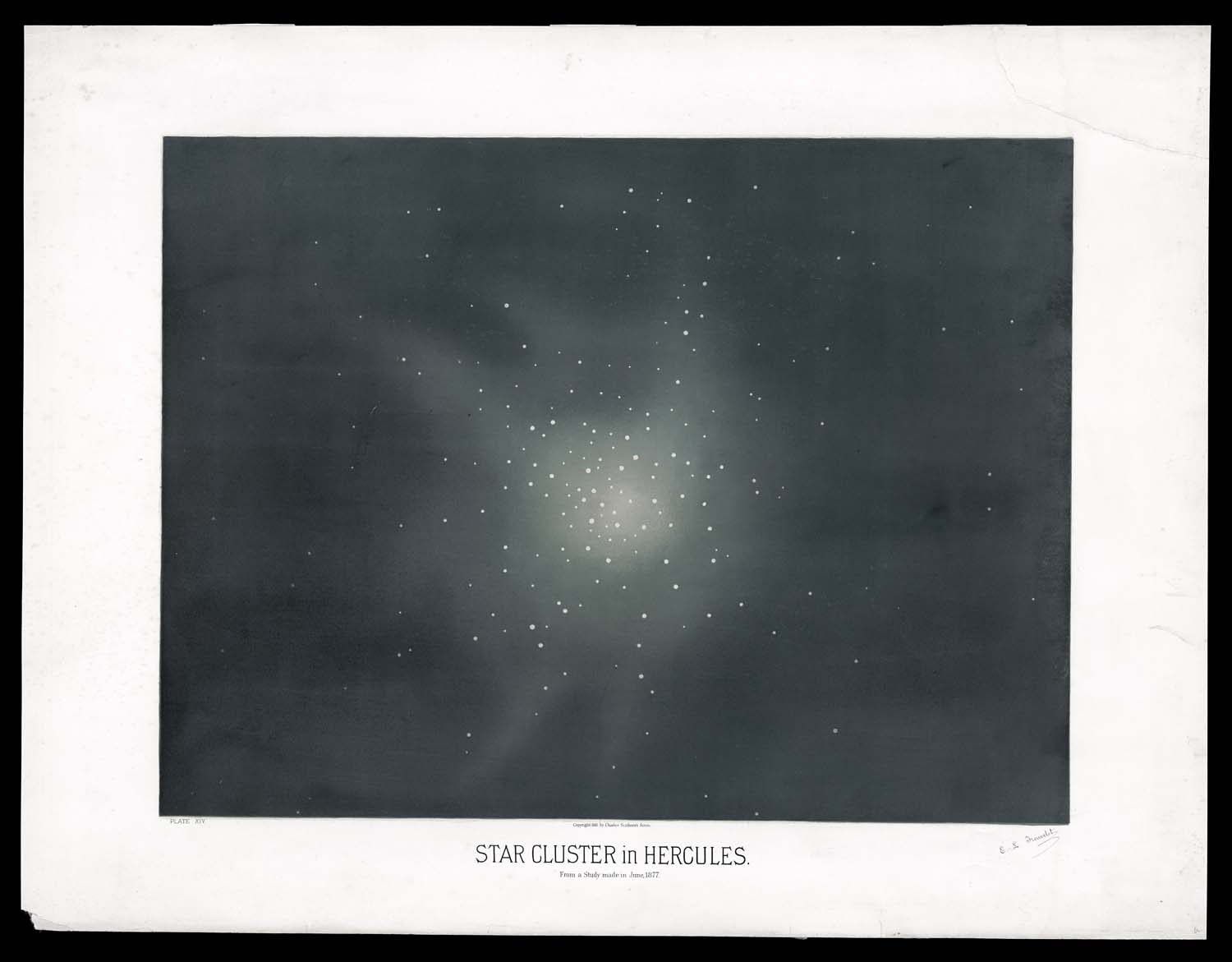
map/50083
Etienne Leopold Trouvelot, Star Cluster in Hercules
From The Trouvelot Astronomical Drawings (New York: Charles Scribner's Sons, 1881), plate XIV
Chromolithograph, 53 x 70.5 cm
OML Collection
URL: www.oshermaps.org/map/50083
“This nebula, which is one of the most brilliant and wonderful of telescopic objects, readily visible to the naked eye as a patch of nebulous light immediately surrounding the middle star of the three which form the sword of Orion, and a little south of the three well-known stars forming the belt. The small stars in this, as in other Plates of the series, are somewhat exaggerated in size, as was unavoidable with any mode of reproduction that could be employed. The bright pentagonal centre of the nebula is traversed by less luminous rifts, the several subdivisions thus outlined being irregularly mottled as if by bright fleecy clouds. Toward the lower part of this bright pentagonal centre is a comparatively dark space containing four bright stars which form a trapezium and together constitute the quadruple star Theta Orionis, which, to the naked eye, appears as the single star in the centre of the sword. On three sides of the central mass extend long bright wisps, whose curves fail, however, to reveal the spiral structure often attributed to this nebula. On the east a broad wing, with wave-shaped inner border, stretches southward. East of the trapezium are two especially noticeable dark spaces. Close to the main nebula on the north-east, a small faint nebula surrounds a bright star, and a branch from another faint stream of nebulous matter forming a loop to the southward, encloses the nebulous star (Iota Orionis) shown at the top of the Plate.”
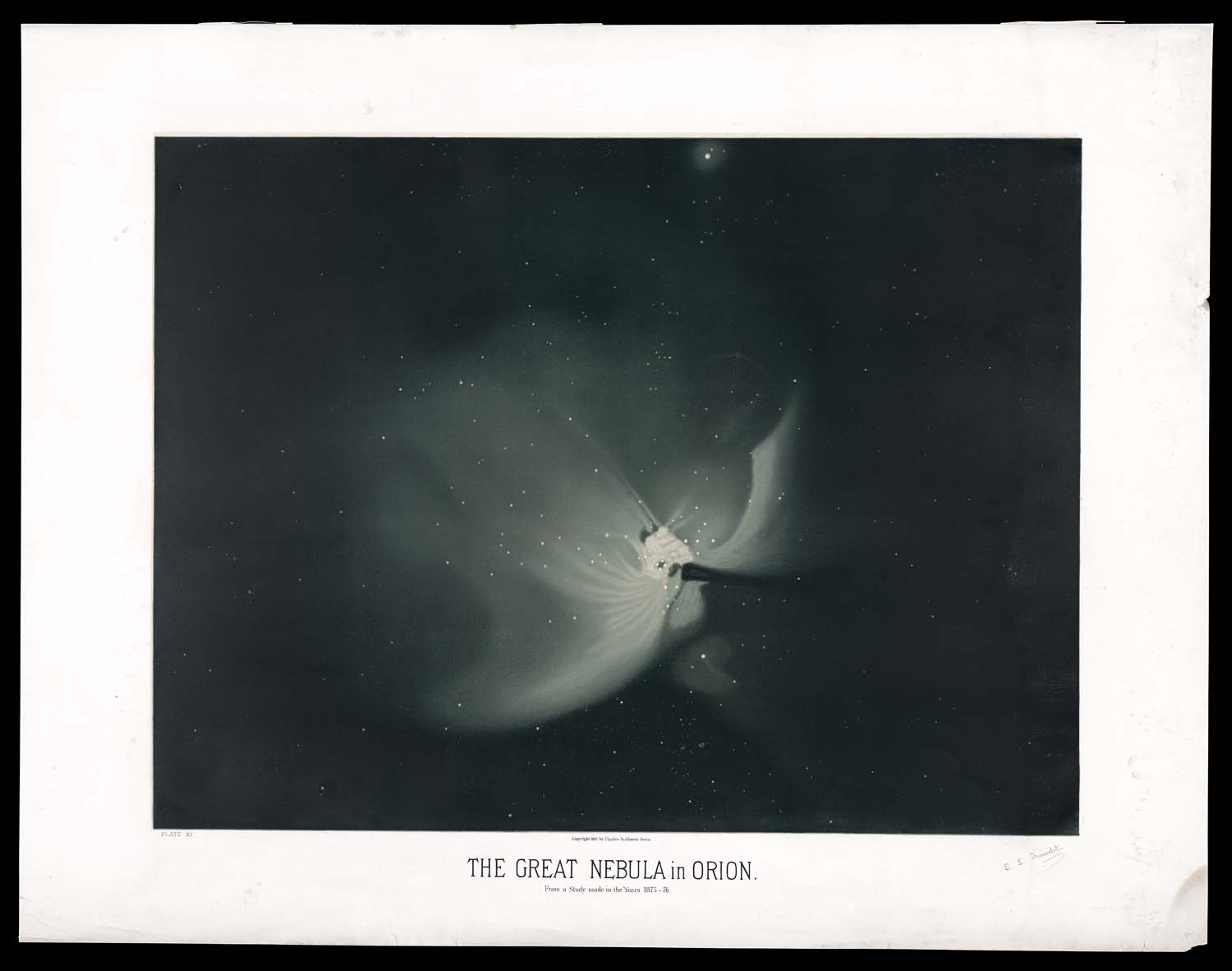
map/50084
Etienne Leopold Trouvelot, The Great Nebula in Orion
From The Trouvelot Astronomical Drawings (New York: Charles Scribner's Sons, 1881), plate XV
Chromolithograph, 53 x 70.5 cm
OML Collection
URL: www.oshermaps.org/map/50084